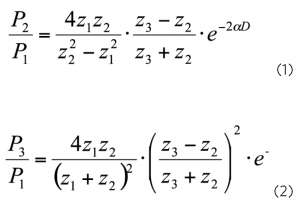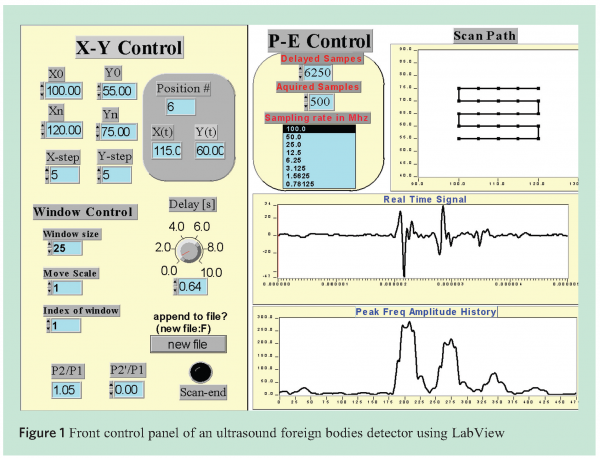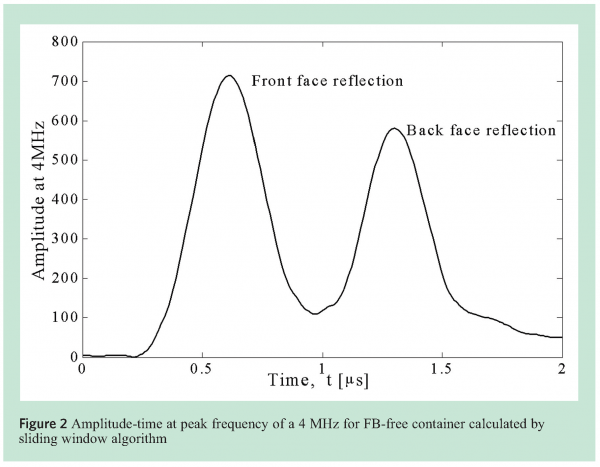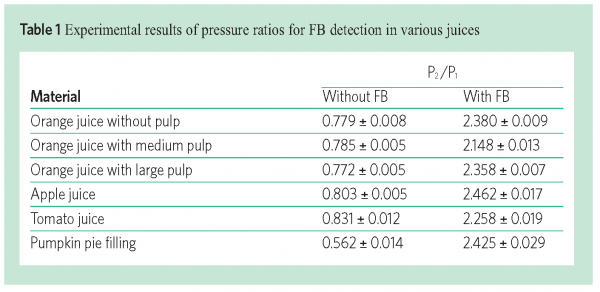Online detection of foreign bodies in packaged foods using ultrasound
- Like
- Digg
- Del
- Tumblr
- VKontakte
- Buffer
- Love This
- Odnoklassniki
- Meneame
- Blogger
- Amazon
- Yahoo Mail
- Gmail
- AOL
- Newsvine
- HackerNews
- Evernote
- MySpace
- Mail.ru
- Viadeo
- Line
- Comments
- Yummly
- SMS
- Viber
- Telegram
- Subscribe
- Skype
- Facebook Messenger
- Kakao
- LiveJournal
- Yammer
- Edgar
- Fintel
- Mix
- Instapaper
- Copy Link
Posted: 10 September 2009 | Gauri S. Mittal, Professor, School of Engineering, University of Guelph | No comments yet
The presence of foreign bodies (FBs) in processed foods is one of the major concerns of the food industry, and their detection and identification are important in quality assurance and safety. An FB is any undesirable piece of solid matter present in a food product. When foods are manufactured or packaged, small foreign objects might end up in the product. For example, in the process of packaging food in glass bottles, occasionally fragments of glass are a result of shattering and breakage of the bottle top, and they find their way into the glass containers. Contamination can also be the result of metal scarf joints that originate from production equipment.
The presence of foreign bodies (FBs) in processed foods is one of the major concerns of the food industry, and their detection and identification are important in quality assurance and safety. An FB is any undesirable piece of solid matter present in a food product. When foods are manufactured or packaged, small foreign objects might end up in the product. For example, in the process of packaging food in glass bottles, occasionally fragments of glass are a result of shattering and breakage of the bottle top, and they find their way into the glass containers. Contamination can also be the result of metal scarf joints that originate from production equipment.
The presence of foreign bodies (FBs) in processed foods is one of the major concerns of the food industry, and their detection and identification are important in quality assurance and safety. An FB is any undesirable piece of solid matter present in a food product. When foods are manufactured or packaged, small foreign objects might end up in the product. For example, in the process of packaging food in glass bottles, occasionally fragments of glass are a result of shattering and breakage of the bottle top, and they find their way into the glass containers. Contamination can also be the result of metal scarf joints that originate from production equipment.
Bone pieces are found in ground meat and deboned reconstituted chicken products. Therefore, it is desirable that all FBs are detected and removed from products before they reach the consumers. Ultrasound-based measurement is a promising method because it has the ability to differentiate discontinuity of acoustic impedance between different regions within a given volume. In addition, it does not spoil foods physically or hygienically when used in non-destructive mode. FBs are different from food in terms of acoustic impedance, which is the product of density and sound velocity in a given food. Reflections, refractions and scattering take place due to discontinuity in acoustic impedance along the sound propagation path through the food. Many ultrasound propagation parameters such as attenuation/absorption, backscatter, velocity and nonlinearity are used.
FBs in cheeses were detected and identified by checking the amplitude pattern of reflected pressure obtained by water immersion method1. An air-coupled ultrasonic transducer pair was used to detect FB in polymer-based soft drink bottles by examining the through – transmitted signal2. Glass fragment detection inside a glass bottle is significantly different from the FB detection3 regarding signal processing. In the case of a FB embedded in the cheese or FB suspended in the juice, time domain methods can be used. FBs can be detected by checking the appearance of echoes at intervals. However, when the glass fragments settle on the base of the bottle, the echoes from the fragments will be superimposed with those from the inner surface of the base. Visually, one cannot find any FB clues using the inner surface echoes in a time domain.
Theory and operation
There are two modes to perform the measurement: pulse/echo (P/E) mode and through-transmission (T) mode. In P/E mode, a transducer transmits impulsive ultrasound signals to the material and receives the echoes from it. The ultrasound velocity in the material of interest is calculated by the echo’s round-trip distance and time elapsed. T mode employs two transducers to execute the same task, one is the transmitter and the other is the receiver. Ultrasonic pulse echo detects defects, flaws and particles in products by examining either the reflected signal amplitude or arrival time due to impedance discontinuity. With rough surfaced or an arbitrary shaped or small sized discontinuity such as a glass fragment in a bottle, the ultrasound beam is often scattered and the echo signals are low in amplitude. In such cases, it is possible to recognise the presence of the discontinuity by the loss of the echo from the back wall surface of the container if this surface is nearly parallel to the front wall, although the parallel portion could be small for a circular cross section bottle. The transducer is mounted on a universal connector that aligns the incident ultrasound beam from transducer to the normal of the bottle surface. The alignment is controlled by a computer by checking the amplitude of echo signal from the outer surface of the bottle4. The inner surface echo from the back wall of the bottle is examined as soon as the transducer is aligned.
When an ultrasound wave impinges at a normal incidence angle on the interface between two media, part of the incident wave (P) is reflected (P1) and part is transmitted into the second medium. A second reflection (P2) and reverberation (P3) occurs if the second medium is of limited thickness, which is the case of a container/bottle wall. The pressure ratios are calculated by5:


where z is acoustic impedance, the subscripts 1, 2 and 3 stand for materials 1, 2 and 3 respectively; a and D are the attenuation coefficient and the thickness of material 2, respectively.
Equations (1) and (2) demonstrate that the pressure ratios are functions of z3 and D for a given bottle material. In beverage bottles, z3 is either the impedance of the beverage (if there is no FB), or that of the FB. It is therefore possible to detect FBs by computing the pressure ratios. It is also noteworthy that the pressure ratio P3/P1 may be more sensitive for FB detection in some cases than P2/P1 since it is proportional to the square of the impedance difference (z3 – z2).
The transducer used is a flat-focused ultrasonic transducer of nominal frequency 15 MHz. An SR-9000 Pulse/Receiver card (Matec, MA) was used to drive the transducer and to receive the echo signal. A pulse of 4 MHz peak frequency was produced by the SR-9000 at a repetition rate of 2 kHz. The signal sampling frequency was 100 MHz. The beverage container base was scanned by an ultrasonic transducer. Ultrasonic pulses were transmitted upward to the container base. The ultrasonic pulse was redirected back by the outer surface (front face) of the container base as the first reflection and by the inner surface (back face) as the second reflection. By examining the pressure ratio of the two echoes, which is relatively stable, FBs can be detected and identified. By checking the spatial distribution of the ratio, FBs can be localised and their sizes can be estimated.
A Labview 5.0 program (National Instruments) was developed to control the SR-9000 card and the x-y movement, and to process the echo signals simultaneously6. It consisted of a front panel, a block diagram and an icon/connector (Figure 1, page 65). It is composed of three sections: The first section appearing in the upper left corner of the control panel is to control x-y movement. It scans the base of a beverage container line by line. The real-time position of the transducer is monitored and displayed on the monitor. The second section, ‘P – E control’ is to control the signal delay time and signal size, and also controls sample frequency. The third section is to process and display the sampled signal (left lower part window control and right lower part). This includes the signal slicing, offset level removing, windowing, fast Fourier transform (FFT) algorithm and pressure ratio calculation for peak frequency.
Short time Fourier transform (STFT), associated with detecting the time interval of peaks from amplitude-time history of a given frequency, is developed for ultrasonic attenuation and dispersion calculation7. This method, after correction, is proven to have the same accuracy as the traditional spectrum method. By sliding a window on an ultrasound signal, this method records the amplitude of the interested frequency component of Fourier transform for each frame. By detecting the peaks and the time of peaks in the amplitude-time history of a given frequency, the attenuation and phase velocity are obtained. Since only the amplitude of spectrum of Fourier transform is used, this method circumvented the issue of accuracy and ambiguity in phase angle calculation, and is therefore suitable for algorithms of on-line tests or measurements.


Discussion
Figure 2 is a time history of the amplitude at peak frequency of 4 MHz using the Hamming window technique8. The first peak is the amplitude of reflection of the container’s front face and the second peak is that of the back face. The time difference between the two reflections remains unchanged, similar to that for the real time signal, but the peaks were easy to sort out. Using the two peak values, the pressure ratio was computed. If the pressure ratio is larger than a threshold value, an FB is considered to be present. The specimen can be detected as small as 2.5 × 2.5 mm2. An identification experiment was conducted with FB size 10 × 10 mm2 to eliminate the edge effects. Table 1 provides a summary of the results for the measurement of P2/P1 and a comparison with the theoretical predictions. These experiments were performed by applying the ultrasound beam right underneath the FB. The experimental results are in agreement with the theoretical calculations with a maximum relative error of 6.3 per cent.




In the presence of FB, P2 will be different from that of ‘no FB’ due to the change of impedance. However, in practice, the amplitude of P2 can change not only because of the presence of FB but also because of the gap between the transducer and the container or the incident angle of ultrasound from the transducer to the container base, which can vary due to uncertainties in the scanning method. To eliminate the false warning, P2/P1 was calculated since the pressure ratio is not affected by above interferences. The calculation of P2 and P1 is easy in the case of the container with a thick base since the two echoes are clearly separated in time. In the case of thin base, the two echoes could be overlapped in time. In this case, time frequency method is used in signal processing, which enables distinction between two closely spaced echoes9.
The pressure ratios with FB are approximately three times larger than those without FB. This confirms that using pressure ratio comparison is an effective criterion for FB detection. Three orange juices, with and without pulp, have similar pressure ratios in the absence of FB (Table 1). This may be due to the absence of pulp at the container-juice interface in the path of the ultrasound beam. In the presence of FB, the pressure ratios for pulp-free and pulpy orange juices (fairly large pulps) are identical. The pressure ratio for orange juice with medium size pulp is approximately 10 per cent less than that of the two former orange juice types. This could be attributed to pulp insertion between the container base and the FB. The pressure ratios in the cases of juices with FB are smaller than those of water.
Conclusions
An ultrasound system for real-time detection of FBs in food containers was described and worked satisfactorily. The system consisted of an ultrasound echo/pulse transducer and data acquisition and analysis system. Time-frequency domain analysis worked reliably to locate different interfaces in the signal path. Perpendicularity of the transducer to the container wall or base is crucial for reliable detection. The proposed detection system is capable of detecting fine FB’s for various materials, including glass contaminants. Experiments conducted using the prototype showed its ability to detect FBs inside juices in glass bottles.x
References
- Haeggstrom, E., Luukkala, M. (2001). Ultrasound Detection and Identification of Foreign Bodies in Food Products. Food Control 12, 37-45.
- Gan, T.H., Hutchines, D.A., Billson, D.R. (2002). Preliminary Studies of a Novel Air – coupled Ultrasonic Inspection System for Food Containers. J. Food Engg. 53, 315-323.
- Gan, T.H., Hutchines, D.A., Billson, D.R., Schindel, D.W. (2001). The use of Broadband Acoustic Transducers and Pulse-compression Technique for Air-coupled Ultrasonic Imaging. Ultrasonics 39, 181-194.
- Zhao, B., Basir, O.A., Mittal, G.S. (2003a). A Self-aligning Ultrasound Sensor for Detecting Foreign Bodies in Glass Containers. Ultrasonics 41, 217-222.
- Zhao, B, Basir, O.A., Mittal, G.S. (2003b). Detection of Metal, Glass and Plastic Pieces in Bottled Beverages using Ultrasound. Food Res. Int. 36, 513-521.
- Jiang, Y., Zhao, B., Basir, O.A., Mittal, G.S. (2003). LabView Implementation of an Ultrasound System for Foreign Body Detection in Food Products. Food, Agric. & Environ. 1(3-4), 27-35.
- Zhao, B, Basir, O.A., Mittal, G.S. (2005). Estimation of Ultrasound Attenuation and Dispersion using Short Time Fourier Transform. Ultrasonics 43, 375-381.
- Zhao, B, Jiang, Y., Basir, O.A., Mittal, G.S. (2004). Foreign Body Detection in Foods using the Ultrasound Pulse/eco Method. J. Food Quality 27, 274-288.
- Basir, O.A., Zhou, B., Mittal, G.S. (2007). Real-time System for Detecting Foreign Bodies in Food Containers using Ultrasound. US Patent #7 204 129, Apr. 17, 2007.







